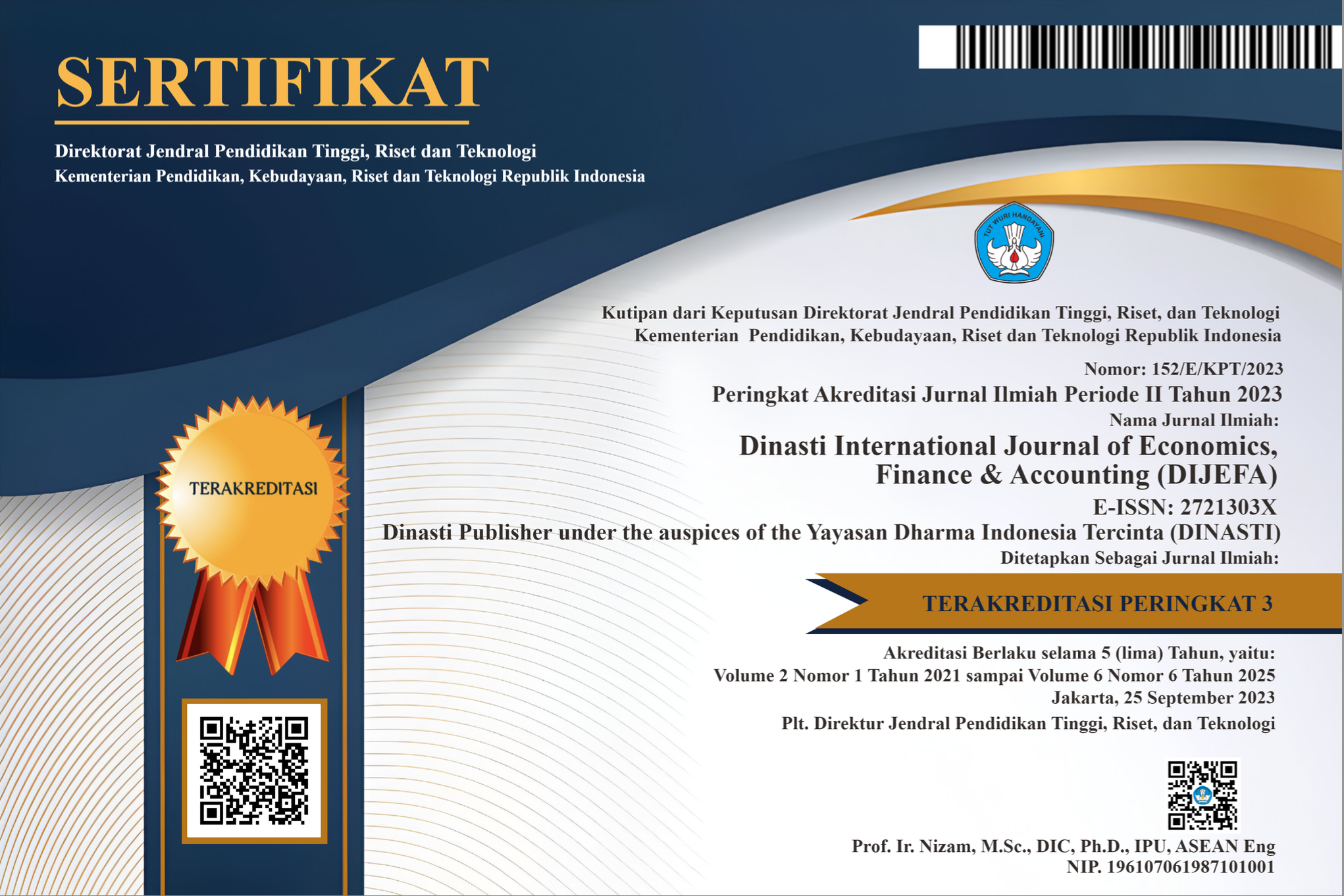Forecasting Volatility Persistence: Evidence from International Stock Markets
DOI:
https://doi.org/10.38035/dijefa.v4i3.1891Keywords:
Volatility persistence, Stock Markets, ARCH model, GARCH model, Market efficiencyAbstract
Volatility persistence represents a notable feature of financial markets and is a widely studied phenomenon that explores the clustering and leverage effects of stock market returns. Recognizing and incorporating volatility persistence into risk management, asset pricing, and portfolio management strategies provide valuable insights for market participants enabling them to navigate and capitalize on the dynamics of market volatility. The aim of this study was to empirically investigate whether the current high volatility in stock markets are temporal or will persist in the future. An ARCH model and a GARCH model were employed to achieve the aim of this study for the JSE, CAC 40, DAX, Nasdaq and Nikkei 225 from May 29, 2023 to May 29, 2018. The findings revealed that stock market volatility will persist at least for some time from the ARCH and GARCH output results. Active traders and market makers need to adapt their strategies in response to the expected volatility persistence. Higher levels of persistence may call for adjustments such as widening stop-loss orders to accommodate larger price swings or using more extended timeframes to capture sustained trends. Portfolio managers may also opt for strategies that thrive in volatile market conditions such as breakout trading or mean reversion strategies
References
Baur, D.G., & Dimpfl, T. (2019). Think again: volatility asymmetry and volatility persistence. Studies in Nonlinear Dynamics & Econometrics, 20, 1-19.
Baek, S., Mohanty, S. K., & Glambosky, M. (2020). COVID-19 and stock market volatility: An industry level analysis. Finance research letters, 37, 101748.
Bollerslev, T. Generalized autoregressive conditional heterosedasticity. Journal of Econometrics, 31: 307-327
Chaudhary, R., Bakhshi, P., & Gupta, H. (2020). Volatility in International Stock Markets: An Empirical Study during COVID-19. Journal of Risk and Financial Management, 13(9), 208.
Engle, R. (1982). Autoregressive conditional heteroscedasticity with estimates of the variance of United Kingdom inflation. Econometrica, 50(1), 987-1007.
Engle, R. (2001). GARCH 101: The Use of ARCH/GARCH Models in Applied Econometrics. Journal of Economic Perspectives, 15(4), 157-168.
Enow, S.T. (2022). Overreaction and underreaction during the covid-19 pandemic in the south African stock market and its implications. Eurasian Journal of Business and Management, 10(1), 19-26.
Enow, S. T. (2023). Forecasting volatility in international financial markets. International Journal of Research in Business and Social Science, 12(2), 197-203.
Enow, S.T. (2023). Investigating Causality and Market Contagion During Periods of Financial Distress and Its Implications. Journal of Accounting, Finance and Auditing studies, 9(1), 140-153.
Gil-Alana, L.A., Infante, J., & Martín-Valmayor, M.A. (2023). Persistence and long run co-movements across stock market prices. Quarterly Review of Economics and Finance, 89, 347- 357.
Godfrey, O.U. & Agwu, E.C. (2018). Volatility Clustering and Persistence of Shocks in The Nigeria Stock Market: Evidence from Univariate GARCH Models. Research Journali’s Journal of Finance, 6(3), 1-11.
Hung, N. (2019). Return and volatility spillover across equity markets between China and Southeast Asian countries. Journal of Economics, Finance and Administrative Science, 24(47), 66-81.
Jin, X. (2017). Time-varying return-volatility relation in international stock markets. International Review of Economics and Finance, 51, 157–173.
Kaczmarek, T., B?dowska-S´ojka, B., Grobelny, P., & Perez, K. (2022). False Safe Haven Assets: Evidence from the Target Volatility Strategy Based on Recurrent Neural Network. Research in International Business and Finance, 60, 101610.
Kaur, M., Jaisinghani, D., & Ramalingam, M. (2019). Do seasonal anomalies still persist? Empirical evidence post-global financial crisis. The Journal of Contemporary Issues in Business and Government, 25(1), 44 – 65.
Magner, N., Lavin, J.F., Valle, M., & Hardy, N. (2021). The predictive power of stock market’s expectations volatility: A financial synchronization phenomenon. PLoS ONE, 16(5): e0250846.
Malik, F., Ewing, B. T., & Payne, J. E. (2005). Measuring Volatility Persistence in the Presence of Sudden Changes in the Variance of Canadian Stock Returns. The Canadian Journal of Economics / Revue Canadienne d’Economique, 38(3), 1037–1056.
Raheem, S.H., Alhusseini, F.H.H., & Alshaybawee, T. (2022). Modelling Volatility in Financial Time Series Using ARCH Models. International Journal of Innovation, Creativity and Change, 12(7),248- 261.
Shim, H., Kim, C., & Choi, Y. (2020). Volatility clustering in data breach counts. Communications for Statistical Applications and Methods, 27(4), 487–500.
Wehrli, A., & Sornette, D. (2022). The excess volatility puzzle explained by financial noise amplification from endogenous feedbacks. Scientific reports, 12(1), 18895.
Zarafat, H., Liebhardt, S., & Eratalay, M. H. (2022). Do ESG Ratings Reduce the Asymmetry Behavior in Volatility? Journal of Risk and Financial Management, 15(8), 320
Downloads
Published
How to Cite
Issue
Section
License
Authors who publish their manuscripts in this journal agree to the following conditions:
- The copyright on each article belongs to the author(s).
- The author acknowledges that the Dinasti International Journal of Economics, Finance & Accounting (DIJEFA) has the right to be the first to publish with a Creative Commons Attribution 4.0 International license (Attribution 4.0 International (CC BY 4.0).
- Authors can submit articles separately, arrange for the non-exclusive distribution of manuscripts that have been published in this journal into other versions (e.g., sent to the author's institutional repository, publication into books, etc.), by acknowledging that the manuscript has been published for the first time in the Dinasti International Journal of Economics, Finance & Accounting (DIJEFA).


























































